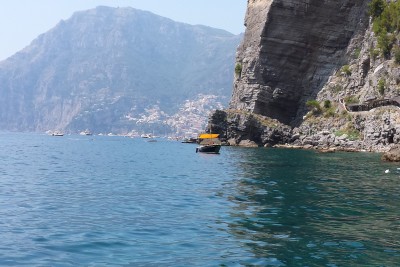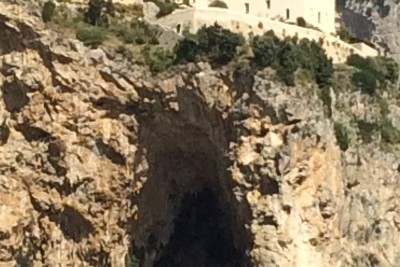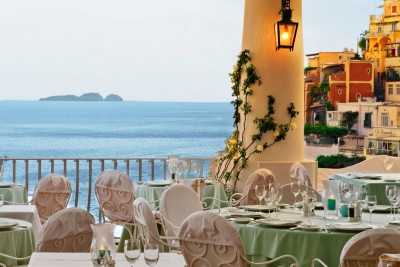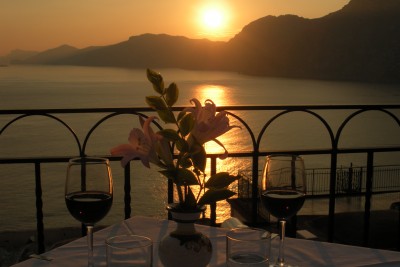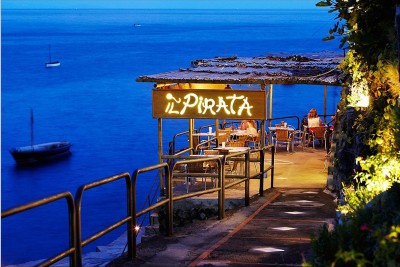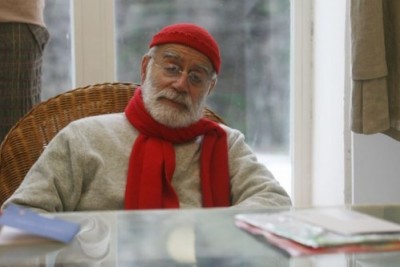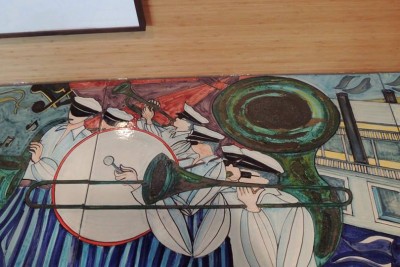A Wine Tour Along the Amalfi Coast Guided by a Local Sommelier
Interested in the wines of the Costiera? Follow our expert in his tour of the best wineries












Producing wines on Amalfi Coast is an almost heroic endeavor. So much so that wine experts often call our vineyards "extreme" because of how hard it is to work on the terraces that overlap one another rising above the sea along steep slopes.
Suffice it to say that traditionally our grape pergolas were built very high, so that the underlying land could also be used as a vegetable garden in the ultimate exploitation of precious space. This practice ended only in recent times with the emergence of the modern wineries.
The characteristics of our area prevented the emergence of large wineries, and even the small or medium ones are relatively recent, but this does not mean that the Amalfi Coast lacks ancient wines. In Tramonti, right above Maiori, there are old grapes that survived the devastating epidemics of phylloxera that, at the beginning of the last century, led to the near extinction of local grapes. There are centennial vines, with enormous trunks that are still producing excellent wines, such as the now famous "’a Scippata”.
In a vineyard near Ravello, I myself have participated in the census of bottles of wine produced immediately after World War I and saw a certificate of participation at a trade show held in England in 1887.
One of the most well-established wineries in the area, which greatly contributed to the success of Amalfi Coast wines all over the world, is Cantine Marisa Cuomo, in Furore, owned by Andrea Ferraioli and Marisa Cuomo.

Its vineyards produce both red and white wines that have been acknowledged by critics and are appreciated by many. Falanghina and Biancolella grapes are used to make the Furore Bianco, while a mix of Per ‘e Palummo, or Piedirosso, and Aglianico grapes produce the Furore Rosso.
The vineyard’s most precious red is the Furore Rosso Riserva, which is aged 12 months in new French oak barrels where it acquires a smooth and well-balanced flavor. Its most successful white is the Fiorduva, a wine of great structure, with special local fragrances such as ginestra, or broom, and wild fennel. Celebrated by many experts in recent years, it is considered among the best Italian whites.
At an altitude of about 500 meters, Cantine Marisa Cuomo overlooks the “Fiordo di Furore”, a beautiful small fjord on Amalfi Coast. The wines of Cantine Marisa Cuomo age in an old wine cellar dug into the dolomitic- limestone rock: a fascinating, cool and damp place which houses the French oak barriques. One can take a one-hour tour of the cellar which includes the vineyards, wine tasting and a visit to a restaurant near the estate for a tasting-lunch.
Visits are offered from January to August by appointment only. For information and bookings visit Cantine Marisa Cuomo website
Going up the coast from Positano in the direction of Vietri sul Mare, I would recommend the Casa Vinicola Ettore Sammarco, located along the road to Ravello. Ettore Sammarco has been running this small but well-respected winery with his children since 1962.

They produce wines such as the Selva della Monaca, from local grapes cultivated in vineyards right below the historic villas of Ravello. These fruity white wines do nt have a powerful structure but are excellent when paired with fish dishes. One of its most interesting whites in my opinion is the Selva della Monaca, which has a great texture and fragrance.
Ettore and his sons also started producing liqueurs typical of the area. Beside the well-known limoncello, they have a wild strawberries and a wild fennel liqueur.
For information and bookings visit the Casa Vinicola Ettore Sammarco website
After Ravello, at about four hundred meters above the town of Maiori, you find the township of Tramonti, made up of a dozen separate hamlets. Among the many wineries there, I’d like to recommend the Tenuta San Francesco.

The winery was founded in 2004 to revive a family tradition which has since then developed a strong personality and two great reds with beautiful and original colors, the "4 Spine" and the “È Iss-Vigna Paradiso”.
Both of these wines are produced in small vineyards with manual harvesting from the local Tintore and Piedirosso grapes. The very original wine tour offered by Gaetano Bove and his daughter includes a visit to the centennial vineyards and their eighteenth century farm. In the cellar, in addition to tasting different wines, you will be offered local cheese and salami.
For information and bookings visit the Tenuta San Francesco website
Another interesting winery in Tramonti is the Azienda Vinicola Monte di Grazia a small producer run by a doctor.

It has been one of the first in the area to be certified organic, and today produces a total of about 6000 bottles a year, with a white, a red and small amounts of an interesting rosé. The latter, produced from Tintore grapes, has more body than usual and is great when paired with fish dishes. The red, also from Tintore grapes, in my opinion becomes is even more interesting when opened after three years.
For information contact Azienda Vinicola Monte di Grazia calling +39 089/876906, or +39 339 2255546 (email: montedigrazia@hotmail.it)
Two more wineries worth considering are the Cantine Giuseppe Apicella, which stands out for its reds, and the Azienda Agricola Reale, which also runs a restaurant and B&B with many genuine products typical of the area.

Giuseppe Apicella started producing wine in 1977 way before his wines had officially obtained the Doc recognition in 1993. Now he is assisted by his daughter Fiorina and son Prisco, who has a degree in Enology from the University of Turin. Their wines are produced in about 15 acres of separate vineyards, the oldest of which was planted early in the twentieth century with indiginous Tintore and Piedirosso grapes and raised with the typical pergola system.
The wines are all worth trying, but the most special is “’a Scippata”, a powerful red blend of Tintore and Piedirosso that has fragrances of tobacco, vanilla, blackberry and plump cherry and beautifully concentrated and redolent of spice as a result of being aged in oak. The vineyard and its cellars are modern and don’t have any particular “flavor” but if you visit the vineyard (by appointment only), beside their excellent wines, you will be offered Giuseppe’s special smoked salami.
For information and bookings visit the Cantine Giuseppe Apicella website
Located in the small hamlet, or borgo, of Gete, the Azienda Agricola Reale has produced wine from local indigenous grapes for about a century.
 Its Getis Rosato Tramonti Costa d’Amalfi Doc 2012, a rosé blend of 80% Piedirosso and 20% Tintore, won the prestigious “Wine Oscar” of Bibenda.it, a website managed by the Italian Foundation of Sommeliers. The Reale family also runs a small traditional restaurant, Osteria Reale, which doubles as a small B&B with only three rooms.
Its Getis Rosato Tramonti Costa d’Amalfi Doc 2012, a rosé blend of 80% Piedirosso and 20% Tintore, won the prestigious “Wine Oscar” of Bibenda.it, a website managed by the Italian Foundation of Sommeliers. The Reale family also runs a small traditional restaurant, Osteria Reale, which doubles as a small B&B with only three rooms.
For information and bookings visit the Azienda Agricola Reale website
Coming down from the mountains of Tramonti, once in Maiori it may be worth making a fast stop to visit the wonderful vineyard with a magnificent location built along the hills of the town.
The winery is called Azienda Agricola Biologica Raffaele Palma and has been officially certified as organic.

Raffaele Palma began his ambitious reconstruction project in 2005, when he started fixing up an old building that he transformed into a wine cellar. He then planted new grapes and revitalized abandoned olive and citrus trees, while respecting the unpolluted land that surrounded the cultivated areas.
The Palma farm now produces organic wine, olive oil, lemons, and is in the experimental phase of the production of saffron.
Its white is the Puntacroce, a blend of Falanghina, Biancolella, Ginestra, and other local varieties, with a fragrance of mandarin, apricot, citrus blossoms and lavender.
Its red, the Montecorvo Amalfi Coast D.O.C., is a blend of Piedirosso, Aglianico, and Tintore and has an intense ruby red color, with the aroma of red plums, oranges and red currents.
Located on a series of rows of terraces that overlap one another rising along steep slopes from about 50 meters above the sea to about 450 meters, the Palma winery offers an amazingly beautiful view of the sea above the Amalfi Coast.
For information and bookings visit the Azienda Agricola Biologica Raffaele Palma website
Finally, near the Southern end of the Costiera, in a beautiful small town above Vietri called Raito, you can find the Le Vigne di Raito winery.

“My first reaction on visiting Raito, overlooking the beautiful coast of Vietri sul Mare, was love at first sight,” owner and founder Patrizia Malanga explains in her website. “In 2001, I found myself owning two hectares of abandoned land. I rolled up my sleeves and started working to restore the site, endeavoring to fully respect both the landscape and environment and decided to plant a vineyard. In 2007, I produced my first red wine, Ragis Rosso. Next came our rosé, Vitamenia Rosato.”
The Ragis Rosso is produced from Aglianico and Piedirosso grapes which are produced separately in stainless steel fermentation vessels and then transferred into big French oak barrels. The wine rests in these barrels for 12 months before it is bottled and continued to age without any further interventions such as clarification or filtration.
The Vitamenia comes from a blend of 20% Aglianico and 80% Piedirosso grapes Fermented separately in stainless steel vessels. After undergoing a soft pressing, it is transferred into 500 liter French oak barrels where for it rests for 6 months before being bottled.
Patrizia’s vineyards, high up in Raito, are in a lovely location overlooking the town and the sea in which makes a wine tasting tour even more worthwhile. If you go, you will be met by Patrizia herself, who will first take you on a walk through the vineyards followed by wine tasting. If you would like you can also arrange for lunch there. h
For information and bookings visit the Le Vigne di Raito website
* Baldassarre Fiorentino is a chef, sommelier and producer of quality wines.

